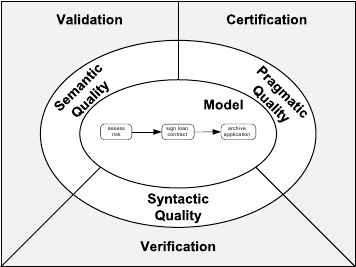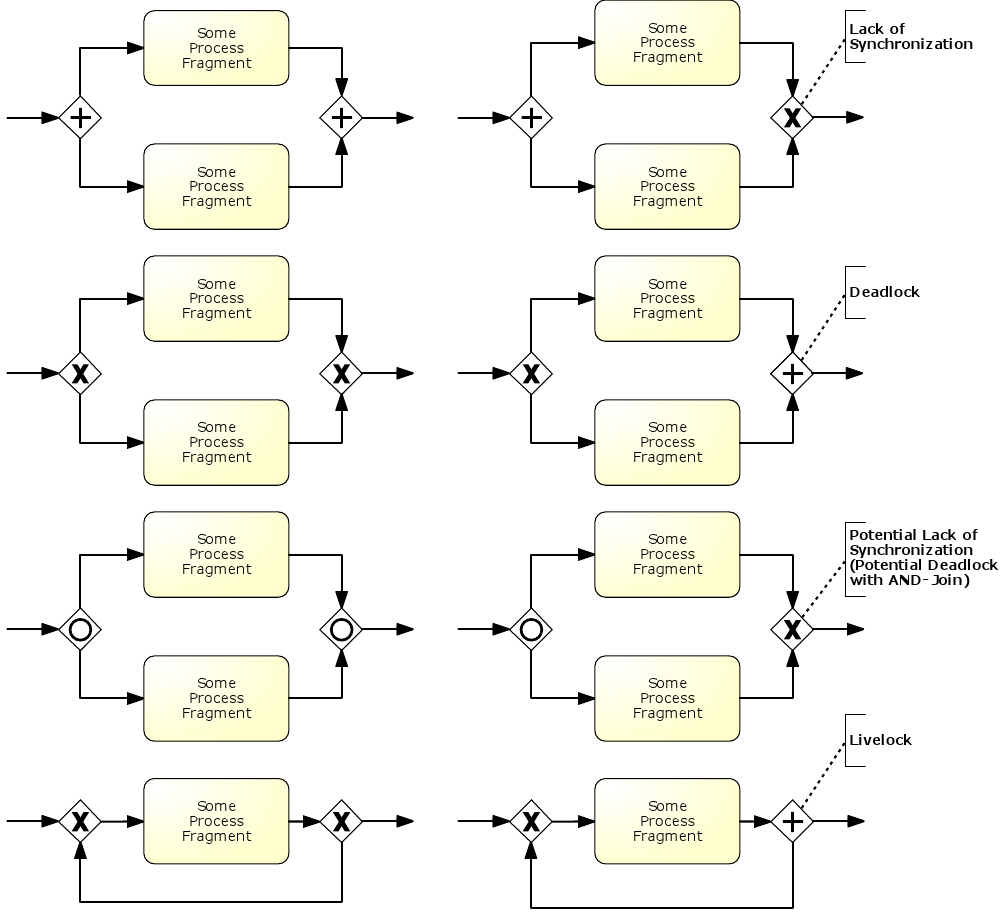5.4 Process Model Quality Assurance
- Gathering information and organizing it in a process model is often done in a sequential way, and not simultaneously, there is a need for various steps of quality assurance.

Syntactic Quality and Verification

- Syntactic quality = Producing a process model that complies with the rules and guidelines.
- Following the modeling language rules (ex. BPMN, no sequence flows across pools)
- Verification = Structural and behavioral correctness.
- Structural correctness = Types of elements used and how they are connected.
- ex. An activity should always have an incoming and outgoing arc.
- Behavioral correctness = Relates to potential sequences of execution defined by the model.
- ex. A case should never be able to reach a deadlock or a livelock.
- Soundness = Common sound an unsound process fragments: See the picture above.
Semantic Quality and Validation
- Semantic quality = Goal of producing models that make true statements.
about the considered domain, either for existing as-is processes or future to-be processes.
- The model has to be compared with the real-world domain of a particular business process.
- There are no formal rules to check semantic quality, it has to pass by the people involved in the process.
- Validation = Checking the semantic quality of a model by comparing it with the real-world business process.
- Validity = All statements included in the model are correct and relevant to the problem.
- A domain expert should point out any difference between what the model states and what is possible in reality.
- Can be checked by simulations and interviews.
- Completeness = The model contains all relevant statements on a process that would be correct.
- Check if all the possible alternative processing options have been accounted for.
Pragmatic Quality and Certification
- Pragmatic Quality = Building a process model of good usability.
- Predict how the model is going to be used.
- Can be checked by how well a user understands the model.
- Certification = Checking the pragmatic quality of a process model by investigating its usage.
- Aspects of usability:
- Understandability = How easy it is to read a specific process model.
- Size of the model, structural complexity, graphical layout.
- Maintainability = The ease of applying changes to a process model.
- Learning = Relates to the degree of how good a process model reveals how a business process works in reality.
- Certification can be conducted using user interviews or user experiments.
- Improve usability by providing usability by applying design rules on the structure of the model.
- Checks for Understandability, Maintainability and Learning:
- Consistency between the visual structure and logical structure.
- Using meaningful labels.
Modeling Guidelines and Conventions
- Modeling Guidelines and Conventions are an important tool to make sure the models are consistent and keep their integrity when multiple people are involved.
- Increase readability and compatibility.
- Using naming conventions, recommends the use of verb-object style for labeling of activities etc.
- Restrictions, for simplifying the set of elements used in BPMN.
- THE SEVEN MODELING GUIDELINES:
- Use as few elements in the model as possible. (Less elements == easier to understand)
- Minimize the routing paths per element. (Less paths == less chance to get errors)
- Use one start and one end event. (Less events == easier to understand)
- Model as structured as possible. (Better structured == easier to understand, less errors)
- Avoid OR-gateways. (No OR-gateways = easier to understand)
- Use verb-object activity labels. ( Less ambiguous == easier to understand)
- Decompose a model with more than 30 elements. (Less elements == easier to understand)

